Me vs. the Powdery Mildew
My squash patch is in a sad state of affairs. I'm well aware that it's mostly my fault, because I planted too many plants too closely together, allowing too little air circulation (and all the rain we've been getting sure hasn't helped). This is the lovely powdery mildew that has been appearing on the great majority of my leaves:
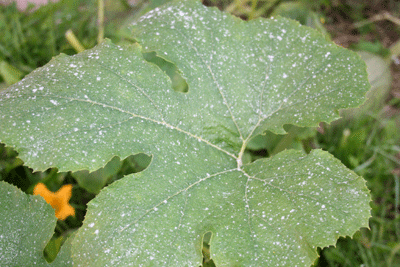
For the past 2-3 weeks, I have been battling this mildew as it spreads like wildfire through my six squash plants, two zucchini plants, and more recently my five cucumbers plants.
Here's what my squash plants looked like before (except enormously bigger- this picture was taken almost two months ago):
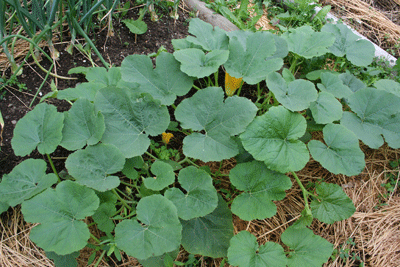
Here's what they look like after 3 weekends of reconstructive surgery:
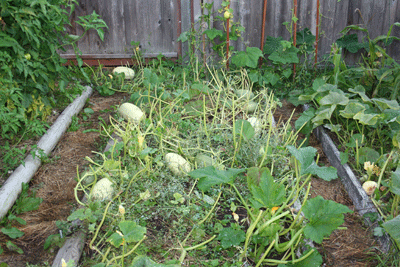
Can you see the difference? Note the stark absence of those green thingamabobs… LEAVES!
At first, I dealt with it timidly, trying to leave enough leaves that there would still be a good deal of shade protecting my precious squash. Bad idea. The mildew realized that I was a pushover and it delighted in giving orders to it's cronies to step in and begin a full assault on what remained.
The second time, I was much better. Any leaf that had a good amount of mildew was gone, whether it left a shady spot or not. The third time, I was ruthless. If it maybe, possibly was affected by the mildew, it didn't make the cut (lol, well actually, that's exactly what happened- it did get cut!). You can see the result is a bit devastating.
I even pulled up my darling zucchini plant, the one that has been inundating my kitchen with dinner after dinner containing that lovely green veggie. It had been a good little plant, and though I hated to see it go, it had been severely affected so I opted to just pull it up all at once.
Aside from getting a bit garden-clipper happy, I have been dealing with the mildew by spraying all of the leaves in the area with two things.
1) First, a combination of about a cup of water, with 1/4 tsp of baking soda.
2) Secondly (and possibly more effectively, though it's so hard to tell), with a mixture of milk and water, in a 1:9 ratio (1 part milk, 9 water).
My biggest concern right now is to protect these:
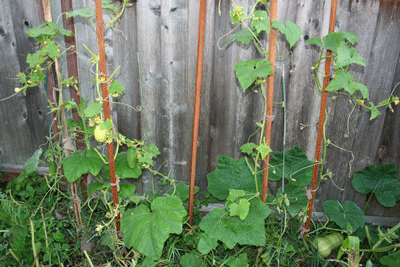
They don't look like much, what with half of their leaves stripped off, but from left to right you see a pickling cucumber, a lemon cucumber, a Japanese long cucumber (it broke accidentally, and is very short, but it's still producing near the ground), and then two more pickling cucumbers. We have been enjoying them only a few short weeks, and I hope to can so many more pickles than the 1 quart I've canned so far (which are so good!), and if the plants can keep going a few more weeks then it looks like I will.
On a good note, let me show you my lovely tomatoes:
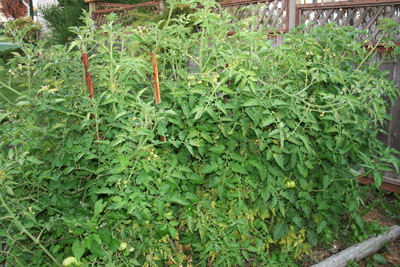
Those wooden stakes sticking through are 5 ft tall, so you can see that the plants are really taking off! Due to so much cool weather here, they aren't quite ripe (although my very first cherry toms are just ripening as I write this!), but they will be very shortly!
And now, two questions for you.
1) The squash on the left is spaghetti squash. The squash on the right doesn't look like anything that I purposefully planted (it's the same shape as the spaghetti, but it's going to turn orange or some other color, I believe). Please, name that mystery squash variety that I am about to be surprised by!
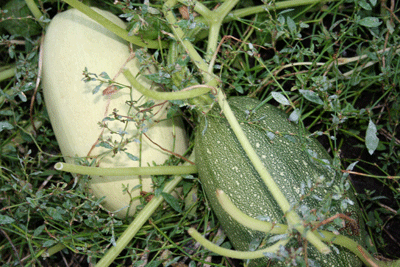
2) What is wrong with my corn? Is it a mold? An insect problem? Something different altogether? Should I pull it out of the garden right away? I can't find the answer online or in any of my books.
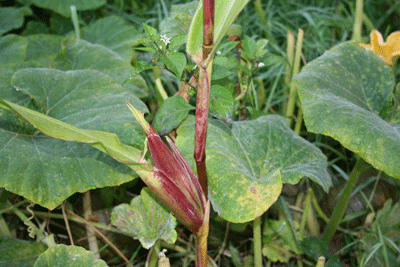
I'm still loving my garden, despite it's current issues, and am just praying for enough heat to ripen all my tomatoes, my cucumbers to be protected just a little longer, and the powdery mildew to be held off long enough for my squash to finish ripening (I figure I need 3-4 more weeks, but what do I know?).




Well I don’t know what to do about the powdery mildew other than spray the plant. I had the same problem with my pumpkins. I got one nice size pumpkin and my yellow squash just shriveled up. Your tomatoes look much better than mine. First we had no rain then we had too much rain!
Manuela
If you have a friend with rabbits ask for a gallon of rabbit poop to make some manure tea for your tomatoes. I know it sounds weird but it works. Take about 1 gallon of rabbit poop and put it into a five gallon bucket. Fill it with HOT water and let it sit outside in the sun for 2-3 days stirring daily. When it is nice and goopy and stinky “water” your tomato plants with it. The manure tea will help your tomato plants to ripen faster! It really does work. We do this trick each fall to encourage the late ripening tomatoes to hurry up!! Rabbit manure is a great natural fertilizer for your garden too so it will also be nourishing your soil.
Happy gardening!!
Hi Stephanie,
My plants all look the same. I just figured they were done and have pulled them out and layed them to rest. More room for fall planting!
Sorry about your tomatoes, Manuela!
Shirley, that sounds like a great idea, but I seriously know no one with rabbits!!! That’s what you get when you live in the city, I suppose. 🙂
I have read, though, that by taking a butter knife through the soil, making a circle around your tomatoes, you can get them to ripen quickly. I guess the root shock from the knife makes the tomatoes think they need to hurry up. I am going to ask someone to do that for me while I’m on vacation!
Candace, I’m with you on the fall planting!
Anything in the squash family is notoriously um… promiscuous so something probably got cross polinated and got in your lot of seeds. Does look like a cross with zuchini. There are some round zuchini out there too.
Corn- It’s probably a phosphorus or potassium deficiency- can’t remember which. I think potassium, it causes the purplish color, although there are a few corn varieties that have more purple color, but that should have been stated on the seed packet as it is a bit of a specialty. Based on the lack of leaves and legginess of the stalk, I’m guessing the deficiency. Hill up the soil at the base of the stalks with some compost, fert with fish emulsion and maybe it will help, but most likely, get a soil test done (cheap through extension service) and correct for next year. Corn is a very needy, high fertilizer plant.
I know this is probably way too late, but vinegar and tea tree oil are natural enemies to mold and mildew. You might [do a little research first and make sure it is not harmful to those plants and] make a spray bottle with one or both of those mixed with some water and see if it works. I have only tried it on non-edible plants, but it seems to take care of a lot of nasty bugs that plants tend to get.
Hi there- Did you ever find out what your odd squash was? I have one right now that looks EXACTLY like that- intermingled between my zucchini and spaghetti squash.
Diana, it turned out to be spaghetti squash, with different coloring. I think it must have intermingled a bit with my zucchini or something, but it still had the same taste and texture as spaghetti squash. Strange, hey? 🙂
I have the same mildew problem. We’ve had a couple of massive hale storms in Colorado, so I planted extra plants figuring that the original plants would die from the hale damage, but they’re much stronger than I gave them credit for, and now I have double the plants which has caused a lack of air flow, hence: mildew.
So in your experience, did the plants die due to the mildew? Does it attack the fruit itself? I haven’t taken any actions as of yet, and am hoping that it will take care of itself…wishful thinking.